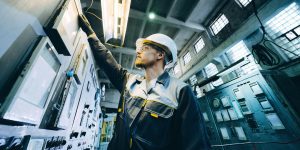The world is now experiencing the convergence of two major crises. The first is the climate crisis, for which most countries are committing to net-zero carbon by 2050. The second is the global energy crisis, with skyrocketing electricity prices having repercussions around the globe.
It’s estimated that up to 50% of today’s buildings will still be in use in 2050, and most of them are wasting up to 30% of the energy they consume. So, it has never been more urgent for building owners and facility managers to retrofit their facilities for more efficient and sustainable operation.
In this blog post, I will explain why facility managers need to lead this decarbonization effort for their organizations and the steps they should take to ensure success. I will also offer an example of how this proven process delivers tangible results with a fast payback.

Why facility managers are the new sustainability champions
If you’re a facility manager or director, you have extensive knowledge of how your buildings operate. You are also in an ideal position to provide strategic and operational guidance to C-level management, your IT group, the purchasing department, and other stakeholders, including clients and tenants.
There are many drivers for sustainability – for a good overview, refer to a post by my colleague Andre Marino. Championing the decarbonization journey will require embracing a vision, setting a strategy, securing commitment, and executing a plan. Let’s look at the first important step you should take.
Determining the total value and ROI of sustainability
Schneider Electric offers a proven 3-step approach to turning sustainability ambition into action. It starts with establishing a solid strategy, then digitizing your operations and taking action on decarbonization.
The first step of setting your strategy is crucial to success and includes building a business case and identifying the business values and return on investment for each proposed activity. The business values you can expect from decarbonization upgrades will be different from one facility to another, but, generally speaking, we can categorize values into:
- Financial values include reducing energy costs and avoiding penalties for non-compliance with regulations.
- Non–financial values such as decreasing CO2 emissions, improving occupant well-being, safety, and satisfaction, and achieving green building ratings help strengthen your corporate profile.
See our eGuide for a more comprehensive list of values to consider. You can choose your targets and KPIs to measure success by evaluating and prioritizing these opportunities.
Most importantly, you will need to understand the return on investment and payback period you can expect from these initiatives. You’ll then be ready to carefully plan every action in your project’s implementation. Let’s look at an example of a successful sustainability retrofit project.
Le Hive: A successful journey to a decarbonized building
Soon after beginning a new lease, the Schneider Electric facility team identified that the HVAC system in their new 35,000 m2 Paris headquarters was wasting energy.
As a first step, the team identified a specific list of goals and KPIs, including reducing energy and achieving payback within the lease period. In terms of non-financial values, the project needed to reduce CO2, improve power reliability, and improve productivity while complying with cybersecurity standards and supporting sustainability certifications. The work also needed to be carried out in a way that was non-disruptive to occupants and visitors.
After setting their plan, the team took action in two steps:
- Digitization – An intelligent network of connected products and software was used to focus first on actions that would bring quick payback. These included: automated adjustment of ambient temperature, management of cold and hot production, and integration with the EcoStruxure Building Operation system to have better visibility into HVAC performance. This helped achieve a 50% reduction in energy consumption. For each action, payback was between 1 to 5 years, with the site becoming three times more energy efficient within only a couple of years. The facility was also the world’s first to comply with the ISO 50001 energy management standard.
- Decarbonization – Efforts focused on optimizing HVAC and integrating renewable energy sources like geothermal or photovoltaic. The payback of these solutions was longer but necessary to reduce 76% of CO2. The building also gained LEED and BREAM certifications.
This project helps to dispel a common myth. Historically, the belief has been that making existing buildings more sustainable can only be achieved by replacing inefficient assets with new, greener products. Of course, this is part of the solution. But this can also add many assets and technology whose performance facility teams are still not measuring or managing.
Each operational team must have the digital tools to understand the fundamentals, i.e., what is your portfolio of buildings ‘saying’ to you? You need to be able to collect and interpret data from your energy assets using a unified system with a single ‘pane of glass’ view. This enables each building to have a backbone of sustainability, with native integration with all building systems, including building automation, power management, and renewable energy sources.
To learn more, download our eGuide to learn more about our proven 3-step approach and proven technologies and services that can help accelerate your journey to digitizing and decarbonizing your buildings. The guide includes a convenient checklist to help you understand where you are on your journey and what steps to take next.



